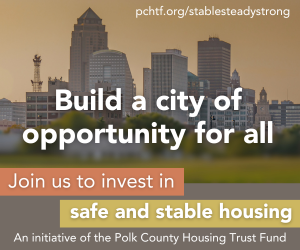Humming along

KENT DARR May 1, 2018 | 5:46 pm
5 min read time
1,249 wordsAll Latest News, Real Estate and DevelopmentThe Business Record Commercial Real Estate Trends and Issues Forum provided some new terms to add to the vocabulary and a look into the mostly “right” direction the local market is headed in.
We’re drawing looks and offers from a diverse group of buyers, including out-of-towners who are drawn to Greater Des Moines by a healthy economy and quality real estate that can produce better yields than the coasts.
Though we have an “extra supply” of apartments — about 3,000 new to the market last year, another 3,000 expected this year — the sector is a “darling” for buyers, as is industrial. The reason: intense competition for quality properties, both on the coasts and here in what has typically been considered “flyover” country. There aren’t enough properties to go around a deepening pool of investors.
Members of the panel for the April 25 event were Brian Clark, director of real estate development for Ryan Cos. US Inc.; David Maahs, executive vice president of economic development for the Greater Des Moines Partnership; Dylan Mullenix, assistant director of the Des Moines Area Metropolitan Planning Organization; Cara Underwood, managing director for capital markets for Principal Real Estate Investors; and Bill Wright, senior vice president and managing director at CBRE|Hubbell Commercial.
“Hoteling” and “working in neighborhoods” were new terms. The folks at Principal Financial Group know what this is all about, and by later this fall so will workers who move from Kum & Go’s offices in West Des Moines to the Krause Gateway Center in downtown Des Moines. Forget an office cubicle, in the contemporary world you are sharing space, or hoteling.
Workers young and old apparently are being drawn to the idea of moving from spot to spot during the day, sort of like cattle grazing on the open plains. If those workers are moving among folks toiling — do we still toil? — over similar assignments, they might find themselves in a neighborhood. You can thank technology and the ability to do any work from virtually anywhere.
“We’re seeing office change because of the number of people being able to work from home; hoteling is becoming the big concept,” Underwood said. “Principal spent $250 million on our corporate complex, and today 80 percent are hoteling — we call it neighborhoods — the other 20 percent does have cubicles.” In many ways, the panel discussion was about trends to attract and retain folks in all forms of brick-and-mortar real estate.
How do you keep shoppers in malls that are failing? Find a way to get them there and keep them there is an answer; attract and retain. With that in mind, Flix Brewhouse at Merle Hay Mall makes perfect sense, a medical office building going up at Southridge Mall is another example, as are the multifamily developments that have sprouted and will sprout near the mall. A pickleball arena in the Jordan Creek area of West Des Moines is another. Expect to see similar solutions for the several-hundred-thousand square feet of space that will open as Younkers shutters its four stores in Greater Des Moines.
“Across the country, malls seem to be doing less and less well, and as Amazon kind of dominates the retail market, we’re seeing malls wanting to become a mixed-use community,” Clark said. “We’re seeing market-rate housing, senior living added to malls, medical office. We’re kind of keeping our eye on those mall models.”
Shoppers and workers are seeking experiences.
“We’re seeing a number of office users wanting to have close amenities, restaurants, coffee shops,” Maahs said. “This all goes back to the need to retain and attract talent.”
Wright pointed out that the commercial real estate market is “stretching” across Greater Des Moines. At Ankeny’s Prairie Trail, office users are renting spaces in retail districts. Warehouses — we are a crossroads region — are popping up across the metro, some even provide space for retailers who don’t want to pay higher rents in more conventional retail environments.
Underwood also cautioned that some of the consternation about retail might be misplaced.
“Even with foreclosures, e-commerce only accounts for 10 percent of non-auto sales,” she said. “The biggest benefactor is the industrial market because of the number of retailers that need to have distribution buildings and move closer to the consumer. That has had a huge impact in our world.”
Mullenix said one way of temporarily filling empty spaces in malls is through pop-up stores. Because they are transient, opening and closing in just a few months, they can help attract shoppers who are seeking new experiences. Wright cautioned, however, that “short-term leases don’t add investment value to space.”
Another trend shaping up in Greater Des Moines is an uptick in investors from outside the state, drawn by a stable economy and top-notch real estate. Investors are drawn to the area because of competition for a limited supply of quality properties on the coasts, our panelists said. They are finding stable investments with good returns in the metro.
“We have a general theme of escalating rents in our market that really wasn’t there 10 years ago,” Wright said. “That is really exciting for outside investors. It’s a stable economic position, quality real estate; in comparison to the coasts, return rates in Des Moines are 200 basis points higher.”
The same holds true for investors in industrial properties.
“Outside investors want stability,” Clark said. “Large [real estate investment trusts], institutional investors, they can count on distribution centers with Fortune 100 companies for that return. Des Moines is the crossroads of distribution, and we’re going to see a lot more of that in Des Moines.”
Underwood said domestic and foreign investors are finding limited supply on the coasts. In the search for yields, “we are starting to see them move into the center of the country.”
The impact of technology is playing a major and unpredictable role in the commercial real estate market. Mullenix pointed out that autonomous vehicles could ease parking woes in urban areas while also making the suburbs more attractive for workers who can spend an hour working instead of gripping a steering wheel during a commute.
It also could ease the worker shortage in the construction industry, he said.
That shortage is severe. “We are tapped out for labor,” Clark said. Ryan Cos. uses its national workforce to plug gaps in areas where there is a shortage.
“The labor shortage is a threat to the expansion of the economy,” Wright said.
Still, Maahs pointed out that “from a big-picture standpoint, the fundamentals are very strong. … Talent is a big issue out there. It’s really an issue nationally. Our peer markets in the Midwest haven’t seen the growth we have. Amenities are critical to keep the momentum going.”
For the future, Underwood said to expect an emphasis on sustainable buildings. Mullenix agreed and said it is important to consider whether to adopt new technologies — whether those technologies provide constant energy usage data or detect a pothole — just because they are available.
“You have to determine what you are trying to solve” with technology, he said.
With millennials driving many of the changes in commercial real estate, from our work environments to the way we shop, Clark said his company is asking the question, “What happens when the millennials grow up? What does that mean for downtowns, what does that mean to our infrastructure, our education system? When their kids need to go to school, will that be downtown or back in the suburbs?”









